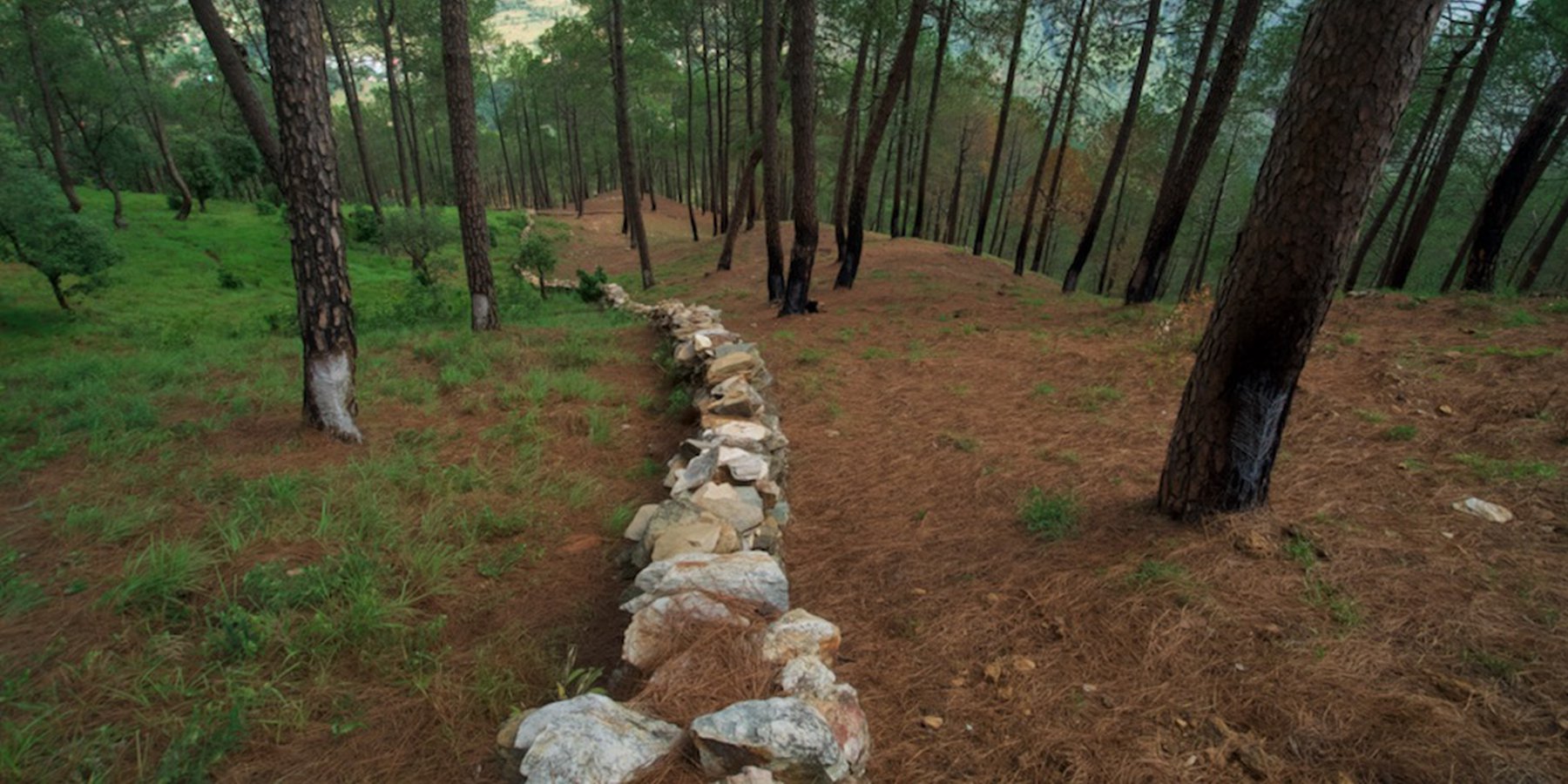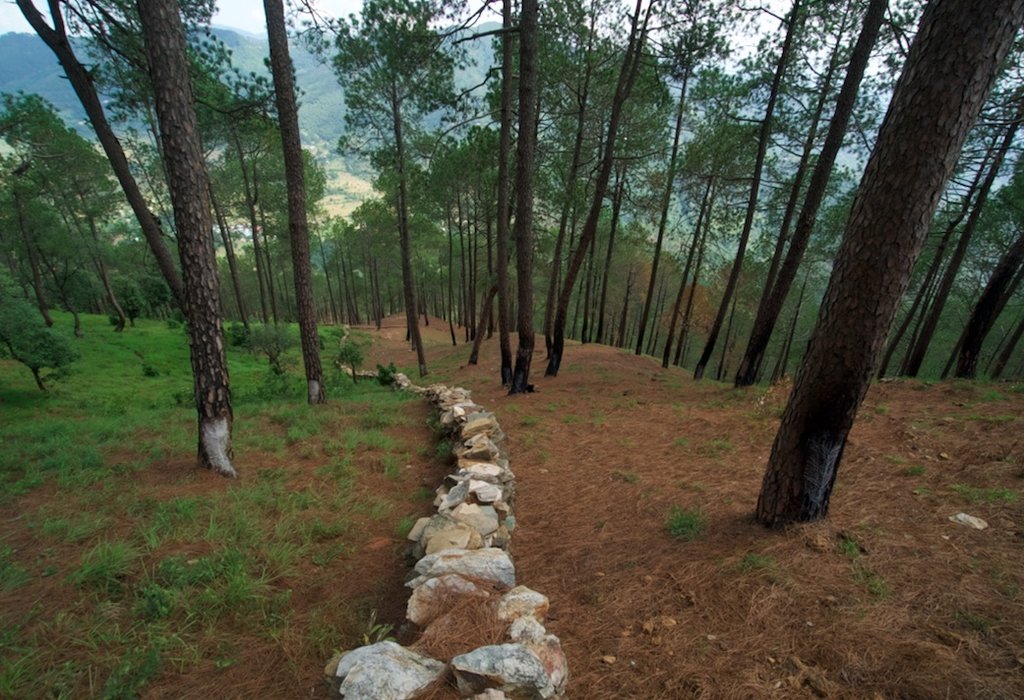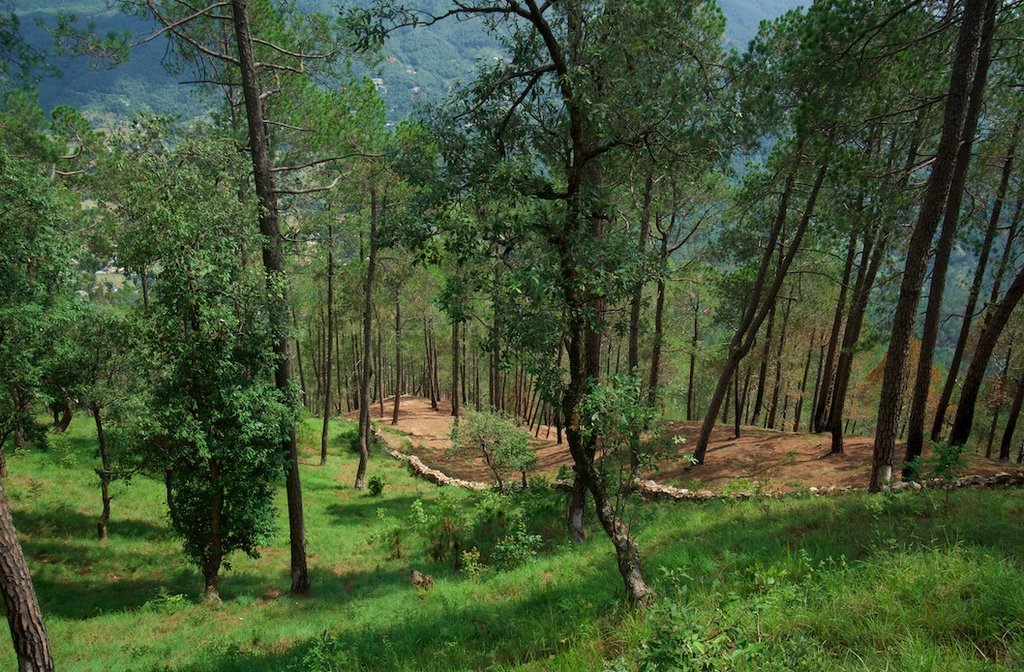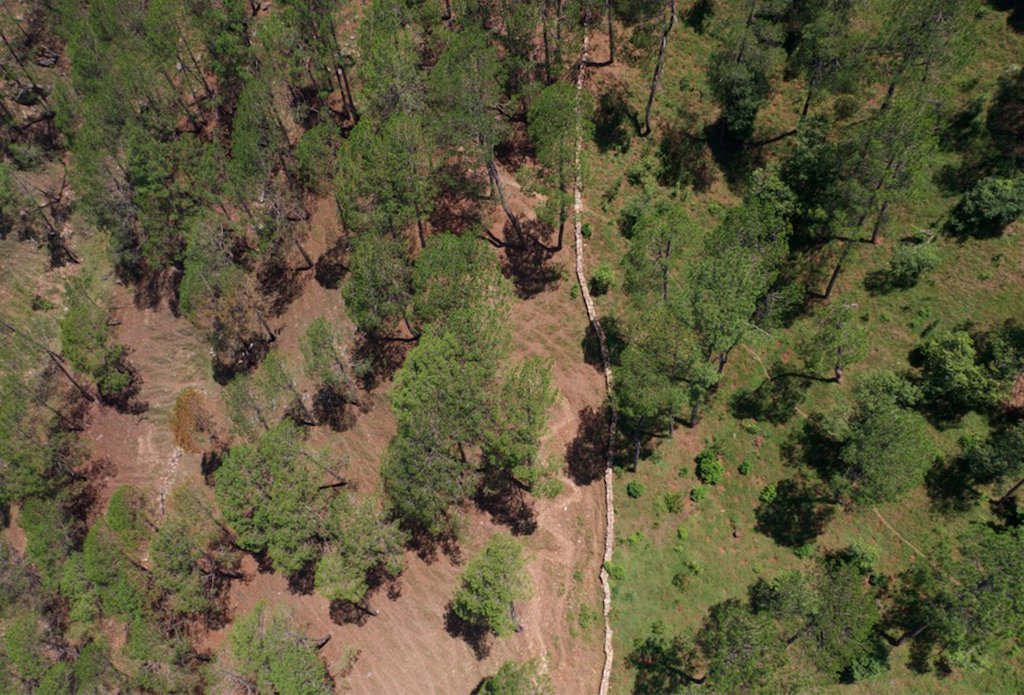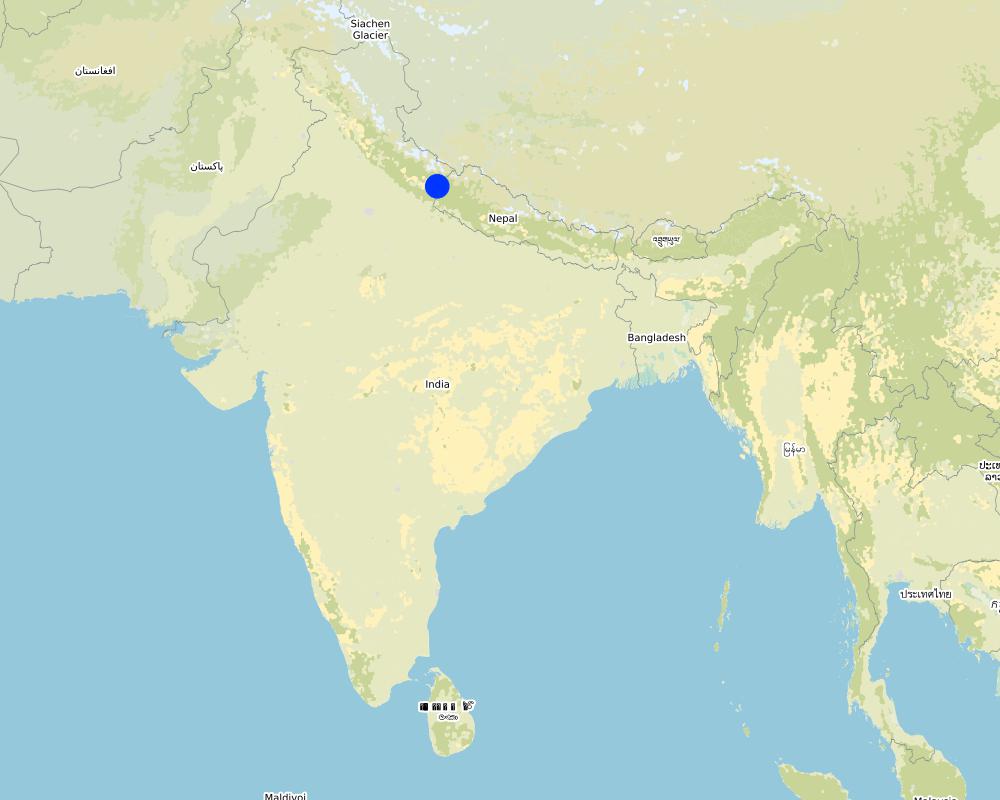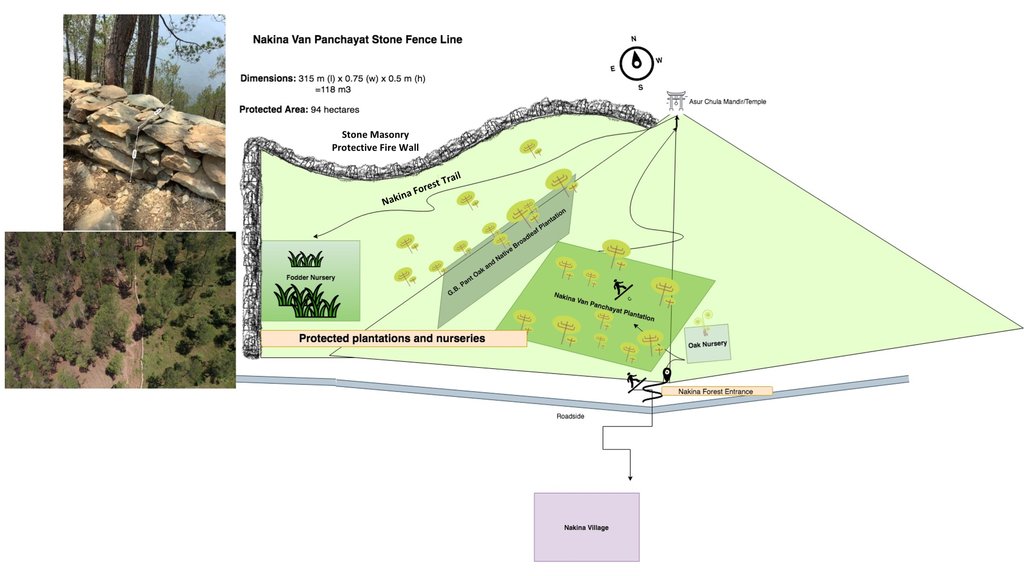Stone Wall Fencing and Firebreak for Forest Protection [Índia]
- Criação:
- Atualização:
- Compilador/a: Jaclyn Bandy
- Editor: –
- Revisor: Hanspeter Liniger
technologies_5201 - Índia
Veja as seções
Expandir tudo Recolher tudo1. Informação geral
1.2 Detalhes do contato das pessoas capacitadas e instituições envolvidas na avaliação e documentação da tecnologia
Pessoa(s) capacitada(s)
usuário de terra:
Joshi Jagdamda
Sarpanch, Nakinia Van Panchayat (Forest Community Head)
Índia
Nome do projeto que facilitou a documentação/avaliação da Tecnologia (se relevante)
Onsite and Offsite Benefits of SLMNome da(s) instituição(ões) que facilitou(ram) a documentação/ avaliação da Tecnologia (se relevante)
ICIMOD International Centre for Integrated Mountain Development (ICIMOD) - NepalNome da(s) instituição(ões) que facilitou(ram) a documentação/ avaliação da Tecnologia (se relevante)
G.B. Pant Institute of Himalayan Einvironment & Development (G.B. Pant Institute of Himalayan Einvironment & Development) - Índia1.3 Condições em relação ao uso da informação documentada através de WOCAT
O/a compilador/a e a(s) pessoa(s) capacitada(s) aceitam as condições relativas ao uso de dados documentados através da WOCAT:
Sim
1.4 Declaração de sustentabilidade da tecnologia descrita
A tecnologia descrita aqui é problemática em relação a degradação da terra de forma que não pode ser declarada uma tecnologia de gestão sustentável de terra?
Não
1.5 Referência ao(s) questionário(s) sobre abordagens GST (documentado(s) usando WOCAT)
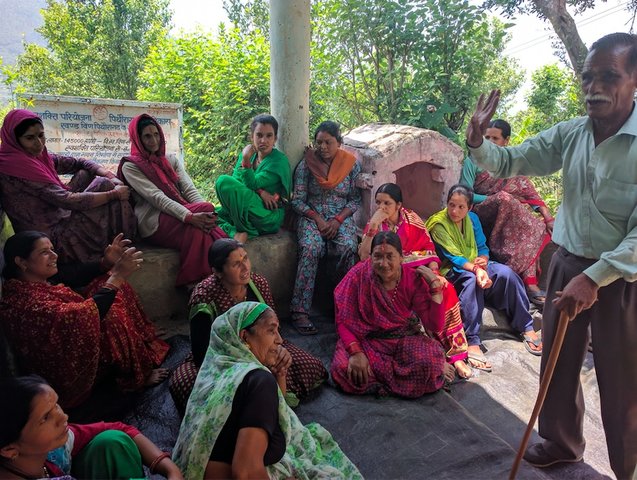
Community Forest Management in the Nakina Van Panchayat [Índia]
Van Panchayats or village forest councils are a impressive example of grassroots community management of natural resources, where a specific administrative unit is locally elected by community members who are responsible for the management of activities related to the forest.
- Compilador/a: Jaclyn Bandy
2. Descrição da tecnologia de GST
2.1 Descrição curta da tecnologia
Definição da tecnologia:
A rubble stone wall demarcates the community forest of Nakina Village and acts as a protective barrier against wildfire, wildlife, grazing, and human encroachment. The stone wall fencing is complemented by a firebreak, which is a gap of 2 meters. Firebreak establishment requires the removal of pine needles and debris from the border of the wall, so as to reduce the fuel load and possibility of fire spreading to the community forest.
2.2 Descrição detalhada da tecnologia
Descrição:
1. The technology has applied in the natural environment (Nakina Van Panchayat)
2. Characteristics of the technology:-
It is a dry stone wall in the community forest.
The wall (3.15km, 1m height, 80 cm width) is 40 years old and is being regularly maintained. The community is currently extending it to 4km.
3. Purpose and function of the technology:-
To protect the forest from forest fires.
To protect the fodder grasses from grazing animals
To protect the community forest from encroachment
To make a margin between two community forests.
4. Major activities and inputs needed to establish and maintain the technology:
Obtaining funding and external support to make the stone wall from other agencies (JICA, Forest Department)
The Forest department and Nakina Van Panchayat were the implementing agencies, and received approval from the District Magistrate to build the wall.
Nakina Van Panchayat organized the community people to construct the wall, paying each person 400 INR ($5.20 USD) a day for their work.
The community pooled their own construction materials and rocks were gathered on site.
5. Benefits and impacts of the Technology:
-Helps to protect forest fires from spreading to the Nakina community forest (physical barrier)
-Protect the fodder grasses from grazing animals
-Avoid conflict between two community forests and deter outsiders from crossing the wall
6. Impacts of the technology:
The wall is successful in protecting the forest from wildfire and it inhibits wildlife/livestock movements or passage.
The people of Nakina village are restricted to a particular area to collect fodder and forest products, which helps them regulate and realize their specific resource demands. This helps them avoid overexploitation of forest resources and set limits.
People views about the technology:-
Like: People are very positive about this technology and they believe that extending its length from 3.15km to 4km will further benefit the forest.
Dislike: The aesthetic of the forest is slightly compromised due to the construction wall.
During construction period, the people realized that some noise pollution from breaking stones could have disturbed neighbors grazing their livestock or other wildlife
2.3 Fotos da tecnologia
2.5 País/região/locais onde a tecnologia foi aplicada e que estão cobertos nesta avaliação
País:
Índia
Região/Estado/Província:
Uttarakhand
Especificação adicional de localização:
Naikina Village, Pithoragarh Bloc
Especifique a difusão da tecnologia:
- Uniformemente difundida numa área
Se a área precisa não for conhecida, indicar a área aproximada coberta:
- 0,1-1 km2
O(s) local(is) tecnológico(s) está(ão) localizado(s) em uma área permanentemente protegida?
Sim
Caso afirmativo, especifique:
The Nakina Van Panchayat protects 94 hectares of community forest.
Map
×2.6 Data da implementação
Caso o ano exato seja desconhecido, indique a data aproximada:
- 10-50 anos atrás
2.7 Introdução da tecnologia
Especifique como a tecnologia foi introduzida:
- Como parte do sistema tradicional (>50 anos)
Comentários (tipos de projeto, etc.):
The wall is about 40 years old. It is common to separate community forests through stone fencing in well-managed Van Panchayat administrations. A stonewall fence is the ideal choice in hilly areas where stones are generally available and local people are able to make it themselves.
3. Classificação da tecnologia de GST
3.1 Principal/principais finalidade(s) da tecnologia
- Melhora a produção
- Reduz, previne, recupera a degradação do solo
- Preserva ecossistema
- Protege uma bacia/zonas a jusante – em combinação com outra tecnologia
- Reduzir riscos de desastre
3.2 Tipo(s) atualizado(s) de uso da terra onde a tecnologia foi aplicada
Uso do solo misturado dentro da mesma unidade de terra:
Sim
Especificar o uso misto da terra (culturas/ pastoreio/ árvores):
- Silvipecuária

Pastagem
Pastagem intensiva/produção de forragem:
- Semiestabulação/sem pastagem
Tipo de animal:
- gado - lácteo
- caprinos
É praticado o manejo integrado de culturas e pecuária?
Sim
Caso afirmativo, especifique:
Manure is left or manually applied to enhance nutrient cycling of the soil and support fodder and tree growth.
Produtos e serviços:
- carne
- leite
Espécie:
gado - lácteo
Espécie:
caprinos

Floresta/bosques
- Plantação de árvores, reflorestamento
Plantação de árvores, florestamento: Especificar a origem e composição das espécies:
- Monocultura de variedade local
Tipo de plantação de árvores, florestamento:
- plantação de floresta seca subtropical - Latifoliada
- quercus leucotrichophora, quercus glauca
As árvores especificadas acima são decíduas ou perenes?
- decíduo
Produtos e serviços:
- Madeira
- Lenha
- Pastagem/Alimentação de folhas e brotos
3.3 O uso do solo mudou devido à implementação da Tecnologia?
O uso do solo mudou devido à implementação da Tecnologia?
- Sim (Por favor, preencha as perguntas abaixo com relação ao uso do solo antes da implementação da Tecnologia)
Uso do solo misturado dentro da mesma unidade de terra:
Sim
Especificar o uso misto da terra (culturas/ pastoreio/ árvores):
- Silvipecuária

Pastagem
Pastagem extensiva:
- Pastoralismo semi-nômade
Tipo de animal:
- gado - lácteo
- gado - sem fins lácteos
- caprinos
É praticado o manejo integrado de culturas e pecuária?
Sim
Caso afirmativo, especifique:
Manure is left or manually applied to enhance nutrient cycling of the soil and support fodder and tree growth.
Produtos e serviços:
- carne
- leite
Espécie:
gado - lácteo
Espécie:
caprinos

Floresta/bosques
- Plantação de árvores, reflorestamento
Plantação de árvores, florestamento: Especificar a origem e composição das espécies:
- Monocultura de variedade local
Tipo de plantação de árvores, florestamento:
- plantação de floresta seca subtropical - Latifoliada
- quercus leucotrichophora, quercus glauca
As árvores especificadas acima são decíduas ou perenes?
- decíduo
Produtos e serviços:
- Madeira
- Lenha
- Pastagem/Alimentação de folhas e brotos
Comentários:
Before the Van Panchayat was established (1952), there was grazing in the forest. Additionally, before the wall was constructed (1979), there was encroachment of livestock belonging to other villagers in the Nakina forest.
3.4 Abastecimento de água
Abastecimento de água para a terra na qual a tecnologia é aplicada:
- Precipitação natural
3.5 Grupo de GST ao qual pertence a tecnologia
- Gestão natural e seminatural de floresta
3.6 Medidas de GST contendo a tecnologia

Medidas estruturais
- S6: Muros, barreiras, paliçadas, cercas

Medidas de gestão
- M1: Mudança no tipo de uso da terra
- M2: Mudança de gestão/nível de intensidade
3.7 Principais tipos de degradação da terra abordados pela tecnologia

Erosão do solo pela água
- Wt: Perda do solo superficial/erosão de superfície
- Wg: Erosão por ravinas/ravinamento
- Wm: movimento de massas/deslizamentos

Degradação biológica
- Bc: redução da cobertura vegetal
- Bh: perda dos habitats
- Bq: quantidade/ declínio da biomassa
- Bf: efeitos prejudiciais de incêndios
- Bs: Qualidade e composição de espécies/declínio de diversidade
- Bl: perda da vida do solo
Comentários:
Soil erosion by water: The wall supports the forest and protected, diverse understory. Thereby, it supports infiltration, decreases runoff and its corresponding damages.
3.8 Redução, prevenção ou recuperação da degradação do solo
Especifique o objetivo da tecnologia em relação a degradação da terra:
- Prevenir degradação do solo
- Reduzir a degradação do solo
4. Especificações técnicas, implementação de atividades, entradas e custos
4.1 Desenho técnico da tecnologia
Especificações técnicas (relacionada ao desenho técnico):
Length: 3.15 km
315 m (l) x 0.75 (w) x 0.5 m (h) = 118 m3
Firebreak: 2m of littler is cleared on each side of the wall (1x per year during the dry season, after pine needles drop in April/May)
Autor:
Jaclyn Bandy
Data:
22/08/2019
4.2 Informação geral em relação ao cálculo de entradas e custos
Especifique como custos e entradas foram calculados:
- Por unidade de tecnologia
Especifique a unidade:
Protective stone wall
Especificar as dimensões da unidade (se for relevante):
3.15 km
Outro/moeda nacional (especifique):
INR
Se for relevante, indique a taxa de câmbio do USD para moeda local (por exemplo, 1 USD = 79,9 Real): 1 USD =:
70,0
Indique a média salarial da mão-de-obra contratada por dia:
400 INR / person
4.3 Atividades de implantação
| Atividade | Periodicidade (estação do ano) | |
|---|---|---|
| 1. | Agreement between Nakina Van Panchayat, JICA and Forest Department for project implementation | Winter |
| 2. | Wall Preparation: Site demarcation, clearing of brush, vegetation, collection of stones | Winter |
| 3. | Random rubble stones of all shapes and sizes are chiseled; inconvenient edges are chipped off | Winter |
| 4. | Stones are piled on top of one another without mortar, and laid in irregular horizontal courses. | Winter |
| 5. | Regular monitoring by administrative committee on the construction site | Year round |
| 6. | Clearing dry pine needles around the dry stone (2m on each side of the wall) annually in the dry season. | April/May |
4.4 Custos e entradas necessárias para a implantação
| Especifique a entrada | Unidade | Quantidade | Custos por unidade | Custos totais por entrada | % dos custos arcados pelos usuários da terra | |
|---|---|---|---|---|---|---|
| Mão-de-obra | Unskilled, semi-skilled work (community) | person/day | 4200,0 | 400,0 | 1680000,0 | 100,0 |
| Mão-de-obra | Skilled (technical experts, trained construction workers) | person/day | 50,0 | 2000,0 | 100000,0 | 100,0 |
| Equipamento | Pick | pieces | 15,0 | 300,0 | 4500,0 | 100,0 |
| Equipamento | shovel | pieces | 20,0 | 500,0 | 10000,0 | 100,0 |
| Equipamento | pharuwa (hoe) | pieces | 15,0 | 300,0 | 4500,0 | 100,0 |
| Equipamento | khanti (digging bar) | pieces | 10,0 | 1500,0 | 15000,0 | 100,0 |
| Equipamento | hammer (5kg) | pieces | 10,0 | 2000,0 | 20000,0 | 100,0 |
| Equipamento | chino (chisel) | pieces | 10,0 | 500,0 | 5000,0 | 100,0 |
| Equipamento | Khukuri (knife) | pieces | 10,0 | 250,0 | 2500,0 | 100,0 |
| Equipamento | Small hammer (0.5-1kg) | pieces | 15,0 | 300,0 | 4500,0 | 100,0 |
| Custos totais para a implantação da tecnologia | 1846000,0 | |||||
| Custos totais para o estabelecimento da Tecnologia em USD | 26371,43 | |||||
Comentários:
Calculation for Labor: 0.75m/person/day
Hired Labor/Day: 30 people
Total Wall Construction/Day: 22.5m/day
Time: 3.15 km (3,150m) / 22.5 = 140 days (~ 5month)
Unit = 4200 (140x 30 people)
4.5 Atividades recorrentes/manutenção
| Atividade | Periodicidade/frequência | |
|---|---|---|
| 1. | Maintaining small damages to wall structure | Year-round |
| 2. | Emergency tending to large sites of damage | Monsoon |
| 3. | Frequent visitations during the dry season/fire season | Pre monsoon |
| 4. | Firebreak establishment: clearing of pine needs 2m on each side of the wall | Peak Dry season |
Comentários:
The local people establish a firebreak (2m pine needle/brush clearance) from both sides of the wall. The labor cost is taken up by the community, which is a voluntary action.
4.6 Custos e entradas necessárias pata a manutenção/atividades recorrentes (por ano)
| Especifique a entrada | Unidade | Quantidade | Custos por unidade | Custos totais por entrada | % dos custos arcados pelos usuários da terra | |
|---|---|---|---|---|---|---|
| Mão-de-obra | Unskilled/semiskilled | person-days | 100,0 | 400,0 | 40000,0 | 100,0 |
| Mão-de-obra | Skilled | person-days | 10,0 | 2000,0 | 20000,0 | 100,0 |
| Equipamento | Picks | pieces | 10,0 | 300,0 | 3000,0 | 100,0 |
| Equipamento | Shovel | pieces | 10,0 | 500,0 | 5000,0 | 100,0 |
| Equipamento | pharuwa (hoe) | pieces | 7,0 | 300,0 | 2100,0 | 100,0 |
| Equipamento | khanti (digging bar) | pieces | 7,0 | 1500,0 | 10500,0 | 100,0 |
| Equipamento | hammer | pieces | 5,0 | 2000,0 | 10000,0 | 100,0 |
| Equipamento | chino (chisel) | pieces | 9,0 | 500,0 | 4500,0 | 100,0 |
| Equipamento | khukuri (knife) | pieces | 5,0 | 250,0 | 1250,0 | 100,0 |
| Equipamento | small hammer | pieces | 15,0 | 300,0 | 4500,0 | 100,0 |
| Custos totais para a manutenção da tecnologia | 100850,0 | |||||
| Custos totais de manutenção da Tecnologia em USD | 1440,71 | |||||
Se o usuário da terra arca com menos que 100% dos custos, indique quem cobre os custos remanescentes:
Uttarakhand Forest Department, JICA
Comentários:
The costs of extending the wall to 4km are included in the maintenance costs. "Unskilled laborers" or villagers are payed by the communal funds contributed to the Nakina Van Panchayat.
There is however some remaining financial support from JICA/Uttarakhand Forest Department to maintain the wall (e.g. money to cover the replacement of broken or stolen tools) and technical engineer who comes for periodic checks on the construction progress.
For the current wall extension, the land users are paid by the funds and colletive savings managed by the Nakina Van Panchayat.
4.7 Fatores mais importantes que afetam os custos
Descreva os fatores mais determinantes que afetam os custos:
Labor availability, extent of structural damage to the wall
5. Ambiente natural e humano
5.1 Clima
Precipitação pluviométrica anual
- <250 mm
- 251-500 mm
- 501-750 mm
- 751-1.000 mm
- 1.001-1.500 mm
- 1.501-2.000 mm
- 2.001-3.000 mm
- 3.001-4.000 mm
- > 4.000 mm
Especifique a média pluviométrica anual em mm (se conhecida):
1500,00
Especificações/comentários sobre a pluviosidade:
Monsoon- mid-June to mid-September; July and August are the rainiest months and the temperature is warm and moist; between 70-85% of the annual precipitation occurs in the monsoon season
Indique o nome da estação meteorológica de referência considerada:
India Meteorological Department, Meteorological Centre Dehradun
Zona agroclimática
- Subúmido
The overall climatic condition in the Pithoragarh district is governed by the southwest monsoon. It has a sub-tropical to temperate climate, with three pronounced seasons; summer, winter, and monsoon. The hilly terrain of the Himalayan region has snow cover and is cold during winter with snowfall normally occurring during the months of December to March.
Temperature- The temperature ranges from 0°C to 10°C in winter and from 8°C to 33°C in summer season. However, there is no meteorological observatory in the district. The account of the climate is based mainly on the records of the observations in the neighboring districts where similar meteorological conditions prevail. Variations in temperature are considerable from place to place and depend upon elevation as well as aspect. As the insolation is intense at high altitudes, in summer temperatures are considerably higher in the open than in the shade.
5.2 Topografia
Declividade média:
- Plano (0-2%)
- Suave ondulado (3-5%)
- Ondulado (6-10%)
- Moderadamente ondulado (11-15%)
- Forte ondulado (16-30%)
- Montanhoso (31-60%)
- Escarpado (>60%)
Formas de relevo:
- Planalto/planície
- Cumes
- Encosta de serra
- Encosta de morro
- Sopés
- Fundos de vale
Zona de altitude:
- 0-100 m s.n.m.
- 101-500 m s.n.m.
- 501-1.000 m s.n.m.
- 1.001-1.500 m s.n.m.
- 1.501-2.000 m s.n.m.
- 2.001-2.500 m s.n.m.
- 2.501-3.000 m s.n.m.
- 3.001-4.000 m s.n.m.
- > 4.000 m s.n.m.
Indique se a tecnologia é aplicada especificamente em:
- Posições côncavas
Comentários e outras especificações sobre a topografia:
Average Altitude of evaluated sites: 1990m
Average Slope: 28%
5.3 Solos
Profundidade do solo em média:
- Muito raso (0-20 cm)
- Raso (21-50 cm)
- Moderadamente profundo (51-80 cm)
- Profundo (81-120 cm)
- Muito profundo (>120 cm)
Textura do solo (solo superficial):
- Grosso/fino (arenoso)
- Médio (limoso, siltoso)
Textura do solo (>20 cm abaixo da superfície):
- Médio (limoso, siltoso)
Matéria orgânica do solo superficial:
- Médio (1-3%)
- Baixo (<1%)
Caso disponível anexe a descrição completa do solo ou especifique as informações disponíveis, p. ex. tipo de solo, PH/acidez do solo, nitrogênio, capacidade de troca catiônica, salinidade, etc.
Mountain/hill soils are a collective name given to various types of soils found under the following conditions :
-under sub-tropical, temperate and sub-alpine conditions
-under various forest types
Characteristics: very thin, fertile, and may be less than a centimeter deep on steep slopes; they are mixed with pebbles, shingles (a mass of small rounded pebbles), and gravels; they have a low-medium water holding capacity. Angular and subangular fragments of parent rock may be found mixed with the lower layers of the mountain and hill soils.
Texture: varies from loamy to sandy loam.
Soil Reaction: ranges from acidic to neutral (pH 4.6 to 6.5)
Organic Matter content: 1-5%
Ferrugenous red roils are found in this district and are well developed over Himalayan rocks (quartzite, biotite schist, amphibolite schist). They are free of carbonates and deficient in nitrogen, humus and phosphorus, light textured, porous, and friable (brittle/crumbly). The soil depth ranges from about 10cm-75 cm. These soils may be grouped into two on basis of morphology
1. Red earths- loose, friable topsoil rich in secondary concretions (hard, compact mass of matter formed by the precipitation of mineral cement within the spaces between particles, and is found in sedimentary rock or soil)
2. Red loam- argillaceous soils having a blocky structure (argillaceous minerals may appear silvery upon optical reflection and are minerals containing substantial amounts of clay-like components, e.g. argillaceous limestones are limestones consisting predominantly of calcium carbonate, but including 10-40% of clay minerals)
Brown soil: is found particularly under dense broadleaved temperate and sub-alpine forests. There occurs a thick layer of humus on the forest floor (made of decomposed leaves, branches, twigs) and the topsoil is extremely rich in humus
Podsolic Soil: soil that has developed in humid/temperate conditions usually under coniferous forests (e.g. deodar, blue pine, fir, spruce) over quartzite, granites, schists and gneiss.
5.4 Disponibilidade e qualidade de água
Lençol freático:
5-50 m
Disponibilidade de água de superfície:
Médio
Qualidade da água (não tratada):
Água potável boa
A qualidade da água refere-se a:
águas subterrâneas
A salinidade da água é um problema?
Não
Ocorre inundação da área?
Não
Comentários e outras especificações sobre a qualidade e a quantidade da água:
Quantity: Water crisis has been a perennial problem in both the rural and urban areas of the Pithoragarh district
There is scarcity of safe drinking water of the villages in the study area. Hand pumps are often not functioning, pipe-water schemes are unreliable and the spring discharges have reduced during the dry season. Hand-pumped water often has a high iron content and bitter taste. Poor quality of groundwater in some of the naulas is mainly due to misuse and/or disuse of the structures.
A block-district groundwater resource estimation could not be carried out as the area is hilly (with slope >20%) and in major part aquifers are small, isolated bodies, and groundwater abstraction is done mainly through hand pumps and springs with small discharges.
However, we collected some physicochemical parameters that indicate the water (sourced from springs) is of good quality:
Water Quality Parameters of Springs:
pH: 6.29-8.18
Temp: 19.0-23.5 ºC
Electrical Conductivity: 109-504 µmsiemens
Total Dissolved Solids: 75-385 ppm
Other Parameters (from springs of nearby district, Champawat)
Electrical Conductivity: 127-222 µmsiemens
pH: 7.69-8.24
Calcium: 16-36 mg/l
Magnesium: 4.9-7.3 mg/l
Bicarbonate: 61-134 mg/l
Chloride: 5.3- 8.9 mg/l
Total Hardness as CaCO3: 70-110 mg/l
Source: Government of India Ministry of Water Resources, Central Ground Water Board, 2009 Groundwater Brochure of Champawat District (2009)
5.5 Biodiversidade
Diversidade de espécies:
- Médio
Diversidade de habitat:
- Médio
Comentários e outras especificações sobre biodiversidade:
Uttarakhand has more than 7000 species of medicinal plants and 500 species of fauna. Floral diversity contributes 31% of total floral density of India. Fauna contributes just 1.58% of the total faunal density of the country. There are 119 endemic species of flowering plants in the state that exhibited 2.35% endemism and 35 faunal endemic species. Because it lies at the juncture of India, Nepal and the Tibeten Autononmous region, there often cases of poaching and smuggling of wildlife contrabands, including bear bile, musk pods and leopard skins through the borders. Yarsa Gumba Ophiocordyceps sinensis, commonly known as Caterpillar Fungus, is also illegally traded transboundary in the region, together with various plant species. Due to anthropogenic impacts, changes is soil quality, and climatic elements, the biodiversity of our study site is not as high as in other areas of the Pithoragarh district.
Citation: Sundriyal, M. & Sharma, B. (2016). Status of Biodiversity in Central Himalaya, Applied Ecology and Environmental Sciences, 4( 2), 37-43.
5.6 Características dos usuários da terra que utilizam a tecnologia
Sedentário ou nômade:
- Sedentário
Orientação de mercado do sistema de produção:
- Subsistência (autoabastecimento)
- misto (subsistência/comercial)
Rendimento não agrícola:
- 10-50% de toda renda
Nível relativo de riqueza:
- Pobre
Indivíduos ou grupos:
- Grupos/comunidade
Nível de mecanização:
- Trabalho manual
Gênero:
- Mulheres
- Homens
Idade dos usuários da terra:
- Jovens
- meia-idade
- idosos
Indique outras características relevantes dos usuários da terra:
With recent development in Pithoragarh, an influx of funds coming from outside sources has caused a decline in the importance of agriculture production, which in now marginalized, based on female labour, and mainly conducted for subsistence with little surplus to sell. High caste men do not work in cultivation at all, and male tasks such as ploughing are performed by the Scheduled Caste.
Although most women are still cultivating, their work has lost economic importance. For most families, the produce does not cover the needs of the household and surplus must be bought from the market. Many of the terraces that were formerly fruit orchards (mainly citrus) have been completely abandoned. Farming is less intensive and landholdings are small and fragmented. The main crops are wheat, millet, and pulses, but yields are low as the land is not irrigated. Less livestock (cows, goats, buffalo) is kept because of the labor involved. Very little capital is returned to farming. Crops produced for the markets in the plains are replacing traditional crops to sustain the household.
With exposure to the“Modern” lifestyle, new values have also been accepted. Two children are the norm (the ideal being one son and one daughter, but at least one son in a must). Although access to education is quite good, it does not seem to result in working careers for women.
5.7 Área média de terrenos utilizados pelos usuários de terrenos que aplicam a Tecnologia
- < 0,5 ha
- 0,5-1 ha
- 1-2 ha
- 2-5 ha
- 5-15 ha
- 15-50 ha
- 50-100 ha
- 100-500 ha
- 500-1.000 ha
- 1.000-10.000 ha
- > 10.000 ha
É considerado pequena, média ou grande escala (referente ao contexto local)?
- Pequena escala
5.8 Propriedade de terra, direitos de uso da terra e de uso da água
Propriedade da terra:
- Comunitário/rural
Direitos do uso da terra:
- Comunitário (organizado)
Direitos do uso da água:
- Acesso livre (não organizado)
- Comunitário (organizado)
Os direitos de uso da terra são baseados em um sistema jurídico tradicional?
Sim
Especifique:
Under the Kumaun Panchayat forest rules of 1931 (amended in 1976): A Van Panchayat, (community forest council), can be formed out of non-private land within the settlement boundaries of a village. Accordingly, all villagers are members of the VP upon their approval by a Sub-Divisional Magistrate under the state Revenue Department. The members are collectively referred to as the general body, which selects the management committee members through a democratic process.
Comentários:
5-9 elected members assume control and regulation of forest resources. They additionally raise funds and mobilize the village to protect and support sustainable land use. Presently 12,089 Van Panchayats are entrusted with the management of over 5,449.64 km2 of forests.
5.9 Acesso a serviços e infraestrutura
Saúde:
- Pobre
- Moderado
- Bom
Educação:
- Pobre
- Moderado
- Bom
Assistência técnica:
- Pobre
- Moderado
- Bom
Emprego (p. ex. não agrícola):
- Pobre
- Moderado
- Bom
Mercados:
- Pobre
- Moderado
- Bom
Energia:
- Pobre
- Moderado
- Bom
Vias e transporte:
- Pobre
- Moderado
- Bom
Água potável e saneamento:
- Pobre
- Moderado
- Bom
Serviços financeiros:
- Pobre
- Moderado
- Bom
Comentários:
The situation of infrastructure is difficult and inconsistent in the hill regions because of the terrain. The major infrastructural issues are drinking water and irrigation facilities, electricity, transportation and communication facilities and social infrastructure (housing and education). As for financial services, only the State Bank of India (SBI) is active in the hill regions where it is trying to achieve the objective of 100% financial inclusion. Some villages mentioned buying into into agricultural insurance in the past, however this was a temporary enterprise and they were never compensated after extreme climatic events that occurred and damaged over 70% of their crop.
Though infrastructure and education has generally improved over the years, institutional and marketing networks in the region aimed at supporting hill-farmers are lacking.
6. Impactos e declarações finais
6.1 Impactos no local mostrados pela tecnologia
Impactos socioeconômicos
Produção
Produção de forragens
Quantidade anterior à GST:
2 ton/hectare
Quantidade posterior à GST:
10 ton/hectare
Qualidade da forragem
Comentários/especificar:
More broadleaf species
Produção de madeira
Comentários/especificar:
Fuelwood from broadleaved species is more plentiful
Qualidade da floresta/do bosque
Comentários/especificar:
Less pine encroachment and fire damage, tree lopping for fodder decreased by 15%
Produção florestal não madeireira
Comentários/especificar:
Resin collection has increased, pines residing in the protected forest are not damaged by the fire
Área de produção
Comentários/especificar:
Rehabilitated areas that had previously been barren or overgrazed
Gestão de terra
Comentários/especificar:
Less dispute over land resources with a clear demarcation
Disponibilidade e qualidade de água
Disponibilidade de água para criação de animais
Renda e custos
Despesas com insumos agrícolas
Comentários/especificar:
Less damage to plantation and fodder grasses, improved survivability of saplings and decreased costs of supplementary fodder
Disparidades econômicas
Comentários/especificar:
Decreased fodder availability gap during dry season
Carga de trabalho
Comentários/especificar:
Women have saved approximately 1-2 hours in fodder collection
Impactos socioculturais
Segurança alimentar/auto-suficiência
Comentários/especificar:
Milk production of the livestock has increased due to improved fodder availability/quality
Direitos do uso da terra/à água
Oportunidades culturais
Comentários/especificar:
Improved forest quality and aesthetic of forest surrounding the temple
Oportunidades de lazer
Instituições comunitárias
Conhecimento de GST/ degradação da terra
Comentários/especificar:
Increased attention to landscape features and execution of SLM interventions within the community and Van Panchayat
Atenuação de conflitos
Situação de grupos social e economicamente desfavorecidos
Impactos ecológicos
Ciclo hídrico/escoamento
Quantidade de água
Comentários/especificar:
Improved infiltration and soil WHC
Colheita/recolhimento de água
Escoamento superficial
Lençol freático/aquífero
Evaporação
Solo
Umidade do solo
Cobertura do solo
Perda de solo
Acumulação de solo
Ressecamento/ selagem do solo
Compactação do solo
Ciclo e recarga de nutrientes
Matéria orgânica do solo/carbono abaixo do solo
Biodiversidade: vegetação, animais
Cobertura vegetal
Biomassa/carbono acima do solo
Diversidade vegetal
Espécies exóticas invasoras
Espécies benéficas
Diversidade de habitat
Clima e redução de riscos de desastre
Deslizamentos de terra/fluxos de escombros
Impactos da seca
Impactos de ciclones, temporais
Risco de incêndio
Microclima
6.2 Impactos externos mostrados pela tecnologia
Disponibilidade de água
Caudal confiável e estável em período seco
Capacidade de tamponamento/filtragem
Especificar a avaliação dos impactos fora do local (medidas):
The discharge of the Bhind Naula, Hess Dhara, and Vaishnavi Naula in Nakina Village has improved with the help of this water and soil conserving technology.
6.3 Exposição e sensibilidade da tecnologia às mudanças climáticas graduais e extremos/desastres relacionados ao clima (conforme o ponto de vista dos usuários da terra)
Mudança climática gradual
Mudança climática gradual
| Estação do ano | aumento ou diminuição | Como a tecnologia lida com isso? | |
|---|---|---|---|
| Temperatura anual | aumento | muito bem | |
| Outras mudanças climáticas graduais | Rainfall intensity | aumento | bem |
Extremos (desastres) relacionados ao clima
Desastres meteorológicos
| Como a tecnologia lida com isso? | |
|---|---|
| Trovoada local | bem |
| Tempestade de granizo local | moderadamente |
Desastres climatológicos
| Como a tecnologia lida com isso? | |
|---|---|
| Seca | bem |
| Incêndio florestal | bem |
Desastres hidrológicos
| Como a tecnologia lida com isso? | |
|---|---|
| Inundação súbita | moderadamente |
| Deslizamento de terra | não bem |
Comentários:
Although the wall is structurally sound in most sections, the impact of landslides and flash floods is often too great and significant damage results on areas were the slope is steep.
6.4 Análise do custo-benefício
Como os benefícios se comparam aos custos de implantação (do ponto de vista dos usuários da terra)?
Retornos a curto prazo:
levemente positivo
Retornos a longo prazo:
positivo
Como os benefícios se comparam aos custos recorrentes/de manutenção(do ponto de vista dos usuários da terra)?
Retornos a curto prazo:
positivo
Retornos a longo prazo:
positivo
Comentários:
The work load is quite high for establishment and maintenance of the wall, especially when there is significant damage. Although upkeep can be demanding, the community sees the benefit of their efforts. This is especially recognized when the wall is secure from all sides and the firebreak is established before the fire season begins.
6.5 Adoção da tecnologia
- 1-10%
De todos aqueles que adotaram a Tecnologia, quantos o fizeram espontaneamente, ou seja, sem receber nenhum incentivo/ pagamento material?
- 0-10%
Comentários:
Building an extensive wall, providing necessary tools and giving compensation for the labor adds up to be an expensive endeavor. Though the community initiative to maintain the wall can be managed by the Van Panchayat, external funding is necessary for these villages in most cases.
6.6 Adaptação
A tecnologia foi recentemente modificada para adaptar-se as condições variáveis?
Sim
Caso afirmativo, indique as condições variáveis as quais ela foi adaptada:
- Mudança climática/extremo
Especifique a adaptação da tecnologia (desenho, material/espécie, etc):
The wall is being extended from 3.15 km long to 4 km. The reasoning behind this is that the community believes that it will help protect the forest at a greater scale from wildfire, as the frequency is increasing due to climate change, neglect of forest management and historical pine plantations.
6.7 Pontos fortes/vantagens/oportunidades da tecnologia
| Pontos fortes/vantagens/oportunidades na visão do usuário da terra |
|---|
| Provides protection of the forest from forest fires and livestock grazing |
| More fuelwood and fodder is made available through this protective border |
| Because of determent from grazing and other intruders (human/wildlife), saplings and grasses are protected. This has improved the health of the forest, increased groundwater availability and improved spring recharge due to slowing surface runoff and better infiltration rates within the forest. |
| Pontos fortes/vantagens/oportunidades na visão do/a compilador/a ou de outra pessoa capacitada |
|---|
| In agreement with the landuser |
6.8 Pontos fracos, desvantagens/riscos da tecnologia e formas de superá-los
| Pontos fracos/desvantagens/riscos na visão do usuário da terra | Como eles podem ser superados? |
|---|---|
| Height of the wall can be too short to act as an effective barrier for intense forest fires. | The lack of height can compromised by clearing the pine needles and creating a firebreak on both sides of the wall one additional meter. Placement of vegetation where dryer areas exist (or near grassy meadows) may also act as an effective biological barrier against the fires. |
| Parts of the wall on steep slopes often get damaged or destroyed | Avoid building the wall on steep slopes. If there are vulnerable areas, other reinforcement or alternative building technique maybe necessary. For example, building with the incline of the slope into the mountain side, so that the wall acts as more of a retaining structure. |
| Pontos fracos/vantagens/riscos na visão do/a compilador/a ou de outra pessoa capacitada | Como eles podem ser superados? |
|---|---|
| The stone wall's function is only as good as its construction. Some parts of the wall appear to be built in a secure, durable manner whereas other parts could be easily perturbed by pressure or vibration. | Proper training on engineering a stable wall would benefit the technology and reduce maintenance. Perhaps an external technical person could supervise wall-restoration and make periodic checks. Emphasizing the importance of diligent work on construction can be encouraged and incentivized with a higher wage (e.g. 600 INR instead of 400). |
|
Stone walls have inherent weaknesses against the lateral forces of earthquake. Poorly constructed walls having inadequate interlocking between the inside and the outside faces begin to separate, resulting in to rapid weakening of the wall. |
Assure sure that the measures required to counter these weaknesses are taken during the construction so that in the event of a potentially destructive earthquake, the structure is able to withstand its impact without suffering much damage. It is best to build in areas that have firm soil or rock underneath the topsoil. Soft soils can amplify wall movement during an earthquake. |
7. Referências e links
7.1 Métodos/fontes de informação
- visitas de campo, pesquisas de campo
Two separate field visits, about 5 workers constructing the wall
- entrevistas com usuários de terras
Onsite interview with Mr. Jagdamba Joshi
Quando os dados foram compilados (no campo)?
26/06/2019
7.2 Referências às publicações disponíveis
Título, autor, ano, ISBN:
A TUTORIAL: Improving the Seismic Performance of Stone Masonry Buildings, Jitendra Bothara, Svetlana Brzevm, 2011, ISBN: 978-1-932884-48-7
Disponível de onde? Custos?
https://www.academia.edu/20998004/A_TUTORIAL_Improving_the_Seismic_Performance_of_Stone_Masonry_Buildings
7.3 Links para informações on-line relevantes
Título/ descrição:
Technical Guidelines & Information for Stone Construction In Uttarakhand
URL:
https://www.sheltercluster.org/sites/default/files/docs/disaster_management_and_mitigation_centeruttarakhand-technical_guidelines_information_for_stone_construction_in_uttarakhand_part_i.pdf
Título/ descrição:
Policy Brief: Spring Revival through Sustainable Land Management (SLM) in the Himalayan Foothills: Uttarakhand, North India. Author: Liniger HP, Bandy J, Year: 2020
URL:
https://www.wocat.net/en/projects-and-countries/projects/onsite-and-offsite-benefits-sustainable-land-management/india
Título/ descrição:
Video: SLM for Himalayan Spring Revival. Author: Liniger HP, Bandy J, Year: 2020
URL:
https://vimeo.com/429988881
Links e módulos
Expandir tudo Recolher tudoLinks

Community Forest Management in the Nakina Van Panchayat [Índia]
Van Panchayats or village forest councils are a impressive example of grassroots community management of natural resources, where a specific administrative unit is locally elected by community members who are responsible for the management of activities related to the forest.
- Compilador/a: Jaclyn Bandy
Módulos
Não há módulos


